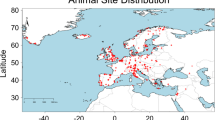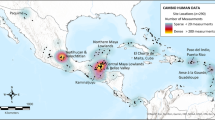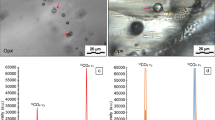Abstract
Measurements of isotope ratios are predominantly made with reference to standard specimens that have been characterized in the past. In the 1950s, the carbon isotope ratio was referenced to a belemnite sample collected by Heinz Lowenstam and Harold Urey1 in South Carolina’s PeeDee region. Due to exhaustion of the sample since then, reference materials that are traceable to the original artefact are used to define the Vienna PeeDee Belemnite scale for stable carbon isotope analysis2. However, these reference materials have also become exhausted or proven to exhibit unstable composition over time3, mirroring issues with the international prototype of the kilogram that led to a revised International System of Units4. A campaign to elucidate the stable carbon isotope ratio of Vienna PeeDee Belemnite is underway5, but independent measurement techniques are required to support it. Here we report an accurate value for the stable carbon isotope ratio inferred from infrared absorption spectroscopy, fulfilling the promise of this fundamentally accurate approach6. Our results agree with a value recently derived from mass spectrometry5 and therefore advance the prospects of International System of Units–traceable isotope analysis. Further, our calibration-free method could improve mass balance calculations and enhance isotopic tracer studies in carbon dioxide source apportionment.
This is a preview of subscription content, access via your institution
Access options
Access Nature and 54 other Nature Portfolio journals
Get Nature+, our best-value online-access subscription
$29.99 / 30 days
cancel any time
Subscribe to this journal
Receive 12 print issues and online access
$209.00 per year
only $17.42 per issue
Buy this article
- Purchase on Springer Link
- Instant access to full article PDF
Prices may be subject to local taxes which are calculated during checkout



Similar content being viewed by others
Data availability
Source data are provided with this paper, and are additionally available at https://doi.org/10.18434/mds2-2369. All other data that support the plots within this paper and other findings of this study are available from the corresponding author upon reasonable request.
Change history
15 June 2021
A Correction to this paper has been published: https://doi.org/10.1038/s41567-021-01293-1
References
Urey, H. C., Lowenstam, H. A., Epstein, S. & McKinney, C. R. Measurement of paleotemperatures and temperatures of the Upper Cretaceous of England, Denmark, and the Southeastern United States. Geol. Soc. Am. Bull. 62, 399–416 (1951).
Coplen, T. B. et al. New guidelines for δ13C measurements. Anal. Chem. 78, 2439–2441 (2006).
Assonov, S. Summary and recommendations from the International Atomic Energy Agency Technical Meeting on the Development of Stable Isotope Reference Products (21–25 November 2016). Rapid Commun. Mass Spectrom. 32, 827–830 (2018).
Phillips, W. D. The end of artefacts. Nat. Phys. 15, 518 (2019).
Malinovsky, D., Dunn, P. J. H., Holcombe, G., Cowen, S. & Goenaga-Infante, H. Development and characterisation of new glycine certified reference materials for SI-traceable 13C/12C isotope amount ratio measurements. J. Anal. At. Spectrom. 34, 147–159 (2019).
Kerstel, E. in Handbook of Stable Isotope Analytical Techniques (ed. de Groot, P. A.) 759–787 (Elsevier, 2004); https://doi.org/10.1016/B978-044451114-0/50036-3
Brand, W. A. & Coplen, T. B. Stable isotope deltas: tiny, yet robust signatures in nature. Isotopes Environ. Health Stud. 48, 393–409 (2012).
Brenna, J. T., Corso, T. N., Tobias, H. J. & Caimi, R. J. High-precision continuous-flow isotope ratio mass spectrometry. Mass Spectrom. Rev. 16, 227–258 (1997).
Flores, E., Viallon, J., Moussay, P., Griffith, D. W. T. & Wielgosz, R. I. Calibration strategies for FT-IR and other isotope ratio infrared spectrometer instruments for accurate δ13C and δ18O measurements of CO2 in air. Anal. Chem. 89, 3648–3655 (2017).
Corso, T. N. & Brenna, J. T. High-precision position-specific isotope analysis. Proc. Natl Acad. Sci. USA 94, 1049–1053 (1997).
Webster, C. R. et al. Isotope ratios of H, C, and O in CO2 and H2O of the Martian atmosphere. Science 341, 260–263 (2013).
Crosson, E. R. et al. Stable isotope ratios using cavity ring-down spectroscopy: determination of 13C/12C for carbon dioxide in human breath. Anal. Chem. 74, 2003–2007 (2002).
Zare, R. N. et al. High-precision optical measurements of 13C/12C isotope ratios in organic compounds at natural abundance. Proc. Natl Acad. Sci. USA 106, 10928–10932 (2009).
Long, D. A., Okumura, M., Miller, C. E. & Hodges, J. T. Frequency-stabilized cavity ring-down spectroscopy measurements of carbon dioxide isotope ratios. Appl. Phys. B 105, 471–477 (2011).
Castrillo, A. et al. Amount-ratio determinations of water isotopologues by dual-laser absorption spectrometry. Phys. Rev. A 86, 052515 (2012).
Kiseleva, M., Mandon, J., Persijn, S. & Harren, F. J. M. Line strength measurements and relative isotope ratio 13C/12C measurements in carbon dioxide using cavity ring down spectroscopy. J. Quant. Spectrosc. Radiat. Transf. 204, 152–158 (2018).
Stoltmann, T., Casado, M., Daëron, M., Landais, A. & Kassi, S. Direct, precision measurements of isotopologue abundance ratios in CO2 using molecular absorption spectroscopy: application to Δ17O. Anal. Chem. 89, 10129–10132 (2017).
Kääriäinen, T., Richmond, C. A. & Manninen, A. Determining biogenic content of biogas by measuring stable isotopologues 12CH4, 13CH4, and CH3D with mid-infrared direct absorption laser spectrometer. Sensors 18, 496 (2018).
Abe, M. et al. Dual wavelength 3.2-µm source for isotope ratio measurements of 13CH4/12CH4. Opt. Express 23, 21786–21797 (2015).
Craig, H. Isotopic standards for carbon and oxygen and correction factors for mass-spectrometric analysis of carbon dioxide. Geochim. Cosmochim. Acta 12, 133–149 (1957).
Assonov, S., Groening, M., Fajgelj, A., Hélie, J.-F. & Hillaire-Marcel, C. Preparation and characterisation of IAEA-603, a new primary reference material aimed at the VPDB scale realisation for δ13C and δ18O determination. Rapid Commun. Mass Spectrom. 34, e8867 (2020).
Tans, P. & Zellweger, C. (eds) 18th WMO/IAEA Meeting on Carbon Dioxide, Other Greenhouse Gases and Related Tracers Measurement Techniques (GGMT-2015) GAW Report No. 229 (WMO, 2016); https://library.wmo.int/opac/doc_num.php?explnum_id=3074
Coplen, T. B. & Shrestha, Y. Isotope-abundance variations and atomic weights of selected elements: 2016 (IUPAC Technical Report). Pure Appl. Chem. 88, 1203–1224 (2016).
Brand, W. A., Assonov, S. S. & Coplen, T. B. Correction for the 17O interference in δ(13C) measurements when analyzing CO2 with stable isotope mass spectrometry (IUPAC Technical Report). Pure Appl. Chem. 82, 1719–1733 (2010).
Chang, T. L. & Li, W.-J. A calibrated measurement of the atomic weight of carbon. Chin. Sci. Bull. 35, 290–296 (1990).
Nørgaard, J. V. et al. The International Measurement Evaluation Programme, IMEP-8: carbon and oxygen isotope ratios in CO2. Anal. Bioanal. Chem. 374, 1147–1154 (2002).
Russe, K., Valkiers, S. & Taylor, P. D. P. Synthetic isotope mixtures for the calibration of isotope amount ratio measurements of carbon. Int. J. Mass. Spec. 235, 255–262 (2004).
Valkiers, S. et al. Preparation of synthetic isotope mixtures for the calibration of carbon and oxygen isotope ratio measurements (in carbon dioxide) to the SI. Int. J. Mass. Spec. 264, 10–21 (2007).
Dunn, P. J. H., Malinovsky, D. & Goenaga-Infante, H. Calibration strategies for the determination of stable carbon absolute isotope ratios in a glycine candidate reference material by element analyser-isotope ratio mass spectrometry. Anal. Bioanal. Chem. 407, 3169–3180 (2015).
Skrzypek, G. & Dunn, P. J. H. Absolute isotope ratios defining scales used in isotope ratio mass spectrometers and optical isotope instruments. Rapid Commun. Mass Spectrom. 34, e8890 (2020).
Yurimoto, H. et al. in Protostars and Planets V (eds Reipurth, B. et al.) 849–862 (Univ. Arizona Press, 2007).
Furukawa, Y. et al. Extraterrestrial ribose and other sugars in primitive meteorites. Proc. Natl Acad. Sci. USA 116, 24440–24445 (2019).
Galli, I. et al. Spectroscopic detection of radiocarbon dioxide at parts-per-quadrillion sensitivity. Optica 3, 385–388 (2016).
Fleisher, A. J., Long, D. A., Liu, Q., Gameson, L. & Hodges, J. T. Optical measurement of radiocarbon below unity fraction modern by linear absorption spectroscopy. J. Phys. Chem. Lett. 8, 4550–4556 (2017).
Prokhorov, I., Kluge, T. & Janssen, C. Optical clumped isotope thermometry of carbon dioxide. Sci. Rep. 9, 4765 (2019).
Truong, G. W. et al. Frequency-agile, rapid scanning spectroscopy. Nat. Photon. 7, 532–534 (2013).
Hodges, J. T., Layer, H. P., Miller, W. W. & Scace, G. Frequency-stabilized single-mode cavity ring-down apparatus for high-resolution absorption spectroscopy. Rev. Sci. Instrum. 75, 849–863 (2004).
Fleurbaey, H., Yi, H., Adkins, E. M., Fleisher, A. J. & Hodges, J. T. Cavity ring-down spectroscopy of CO2 near λ = 2.06 µm: accurate transition intensities for the Orbiting Carbon Observatory-2 (OCO-2) “strong band”. J. Quant. Spectrosc. Radiat. Transf. 252, 107104 (2020).
Fleisher, A. J. et al. Twenty-five-fold reduction in measurement uncertainty for a molecular line intensity. Phys. Rev. Lett. 123, 043001 (2019).
Rhoderick, G. C. et al. Development of a Northern Continental Air standard reference material. Anal. Chem. 88, 3376–3385 (2016).
NOAA Central Calibration Laboratory Reference Gas Calibration Results for NIST Standard Reference Material 1720 Northern Continental Air Serial Number CC324315 (accessed 17 February 2021); https://www.esrl.noaa.gov/gmd/ccl/refgas.html
Milton, M. J. T., Guenther, F., Miller, W. R. & Brown, A. S. Validation of the gravimetric values and uncertainties of independently prepared primary standard gas mixtures. Metrologia 43, L7–L10 (2006).
Srivastava, A. & Verkouteren, R. M. Metrology for stable isotope reference materials: 13C/12C and 18O/16O isotope ratio value assignment of pure carbon dioxide gas samples on the Vienna PeeDee Belemnite-CO2 scale using dual-inlet mass spectrometry. Anal. Bioanal. Chem. 410, 4153–4163 (2018).
Verkouteren, R. M. & Klinedinst, D. B. Value Assignment and Uncertainty Estimation of Selected Light Stable Isotope Reference Materials: RMs 8543–8545, RMs 8562–8564, and RM 8566 NIST Special Publication 260-149 (NIST, 2004); https://www.nist.gov/document-10350
Coplen, T. B. Guidelines and recommended terms for expression of stable-isotope-ratio and gas-ratio measurement results. Rapid Commun. Mass Spectrom. 25, 2538–2560 (2011).
Polyansky, O. L. et al. High-accuracy CO2 line intensities determined from theory and experiment. Phys. Rev. Lett. 114, 243001 (2015).
Huang, X., Schwenke, D. W., Tashkun, S. A. & Lee, T. J. An isotopic-independent highly accurate potential energy surface for CO2 isotopologues and an initial 12C16O2 infrared line list. J. Chem. Phys. 136, 124311 (2012).
Tennyson, J. et al. DVR3D: a program suite for the calculation of rotation–vibration spectra of triatomic molecules. Comput. Phys. Commun. 163, 85–116 (2004).
Conway, E. K., Kyuberis, A. A., Polyansky, O. L., Tennyson, J. & Zobov, N. F. A highly accurate ab initio dipole moment surface for the ground electronic state of water vapour for spectra extending into the ultraviolet. J. Chem. Phys. 149, 084307 (2018).
Mizus, I. I. et al. High-accuracy water potential energy surface for the calculation of infrared spectra. Phil. Trans. R. Soc. A 376, 20170149 (2018).
Werner, H.-J., Knowles, P. J., Knizia, G., Manby, F. R. & Schütz, M. Molpro: a general-purpose quantum chemistry program package. Wiley Interdiscip. Rev. Comput. Mol. Sci. 2, 242–253 (2012).
Long, D. A. et al. High-accuracy near-infrared carbon dioxide intensity measurements to support remote sensing. Geophys. Res. Lett. 47, e2019GL086344 (2020).
Wübbeler, G., Víquez, G. J. P., Jousten, K., Werhahn, O. & Elster, C. Comparison and assessment of procedures for calculating the R(12) line strength of the ν1 + 2ν2 + ν3 band of CO2. J. Chem. Phys. 135, 204304 (2011).
Yi, H., Liu, Q., Gameson, L., Fleisher, A. J. & Hodges, J. T. High-accuracy 12C16O2 line intensities in the 2 μm wavelength region measured by frequency-stabilized cavity ring-down spectroscopy. J. Quant. Spectrosc. Radiat. Transf. 206, 367–377 (2018).
Lodi, L. & Tennyson, J. Line lists for H218O and H217O based on empirical line positions and ab initio intensities. J. Quant. Spectrosc. Radiat. Transf. 113, 850–858 (2012).
Acknowledgements
We acknowledge M. E. Kelley and W. R. Miller Jr, (NIST) for preparing several CO2-in-air gas samples. Funding was provided by the NIST Greenhouse Gas and Climate Science Program. O.L.P. acknowledges partial support from the Quantum Pascal project 18SIB04, which received funding from the EMPIR programme co-financed by the Participating States and the European Union’s Horizon 2020 research and innovations programme. N.F.Z. acknowledges State project 0035-2019-0016.
Author information
Authors and Affiliations
Contributions
A.J.F. assisted with the experimental design, assembly and characterization; performed data analysis; and wrote the Letter. H.Y. assembled optical instrumentation and performed spectroscopy on the CO2-in-air samples. A.S. performed isotope ratio mass spectrometry on the parent CO2 samples. O.L.P. and N.F.Z. performed quantum chemistry calculations of CO2 transition intensities. J.T.H. conceived the experimental design and assisted with instrumentation, data analysis and reduction. All the authors contributed to the final written Letter.
Corresponding author
Ethics declarations
Competing interests
The authors declare no competing interests.
Additional information
Peer review information Nature Physics thanks the anonymous reviewers for their contribution to the peer review of this work.
Publisher’s note Springer Nature remains neutral with regard to jurisdictional claims in published maps and institutional affiliations.
Supplementary information
Supplementary Information
Supplementary Figs. 1 and 2, Discussion and Tables 1–5.
Source data
Source Data Fig. 1
Infrared absorption spectrum of CO2 (Fig. 1b,c).
Source Data Fig. 2
Measurements of R(13C/12C) for several gas samples of CO2 in air (Fig. 2a,b). Upper- and lower-bound δ13C values for some terrestrial and marine sources of carbon (Fig. 2c).
Source Data Fig. 3
Measurements of R(13C/12C) for VPDB (Fig. 3a). Comparison between the value of R(13C/12C)VPDB determined in this work and those available in the literature (Fig. 3c).
Rights and permissions
About this article
Cite this article
Fleisher, A.J., Yi, H., Srivastava, A. et al. Absolute 13C/12C isotope amount ratio for Vienna PeeDee Belemnite from infrared absorption spectroscopy. Nat. Phys. 17, 889–893 (2021). https://doi.org/10.1038/s41567-021-01226-y
Received:
Accepted:
Published:
Issue Date:
DOI: https://doi.org/10.1038/s41567-021-01226-y
This article is cited by
-
Isotopic measurements of carbon dioxide: the role of measurement science and standards
Analytical and Bioanalytical Chemistry (2024)
-
Effects of 13C isotope-labeled allelochemicals on the growth of the invasive plant Alternanthera philoxeroides
Scientific Reports (2023)
-
Operando proton-transfer-reaction time-of-flight mass spectrometry of carbon dioxide reduction electrocatalysis
Nature Catalysis (2022)
-
Characterization of vanillin carbon isotope delta reference materials
Analytical and Bioanalytical Chemistry (2022)
-
Site-specific carbon isotope measurements of vanillin reference materials by nuclear magnetic resonance spectrometry
Analytical and Bioanalytical Chemistry (2022)



